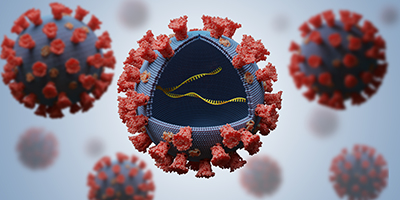By Brad Davidson

RNA viruses invade cells and co-opt cellular machinery to replicate and translate their genomic material. To stave off infection until immune cells arrive, host cells rely on “intrinsic immunity factors” such as proteins already present within the cell. Through the rapid binding of intrinsic immunity factors, host cells might prevent a virus from setting up shop. Although this first contact between host cells and a viruses could be critical for preventing infection, the molecules that comprise intrinsic immunity have been largely understudied—until recently.
Previously developed laboratory techniques can reveal cellular factors that interact with RNA virus genomes upon infection, but none specifically target early interactors. In Molecular Cell, the lab of Manny Ascano, an assistant professor of biochemistry, reports VIR-CLASP, a novel technique to help researchers analyze and compare intrinsic immunity factors that interact with different RNA viruses.
The first step of VIR-CLASP captures pre-labeled viral RNA from infected cells along with any proteins attached to it. Then, mass spectrometry identifies those proteins, creating a list of candidate intrinsic immunity factors. Thisvirus goes unnoticed. Using VIR-CLASP, the Ascano group discovered hundreds of host proteins that bind to the Chikungunya virus genome upon exposure. Forty percent of these factors were previously unknown to bind to RNA.
The authors selected a subset of proteins identified by VIR-CLASP—including YTHDF1 and FASN, among others—to characterize for their effect on CHIKV infection. By modulating the expression of YTHDF1 in infected cells, the Ascano group confirmed that YTHDF1 binds CHIKV RNA and that its binding negatively correlates with virus production. Since proteins in the YTHDF family attach only to an RNA modification known as m6A, the Ascano lab also found that m6A exists in CHIKV. Additionally, the team showed that FASN unexpectedly associates with CHIKV RNA and by doing so spurs viral RNA replication. Previous research described FASN’s role in regulating viral replication, but the mechanism by which it mediated this effect was thought to be entirely based on its enzymatic activities.
While the identities of many intrinsic immunity factors remain enigmatic, this study indicates that these previously unrecognized antiviral factors can contribute to the outcome of infection. Further application of VIR-CLASP could facilitate the identification of additional intrinsic immunity molecules in a wide variety of viruses and conditions. As new RNA viruses such as SARS-CoV-2 arise, an understanding of factors that promote or prevent initial infection through techniques such as VIR-CLASP could be critical for establishing new therapeutics.
This research was supported by the Chemistry-Biology Interface/Chemical Biology of Infectious Disease training grants, the National Center for Advancing Translational Sciences, the National Institutes of Health, and the Vanderbilt University Department of Biochemistry.